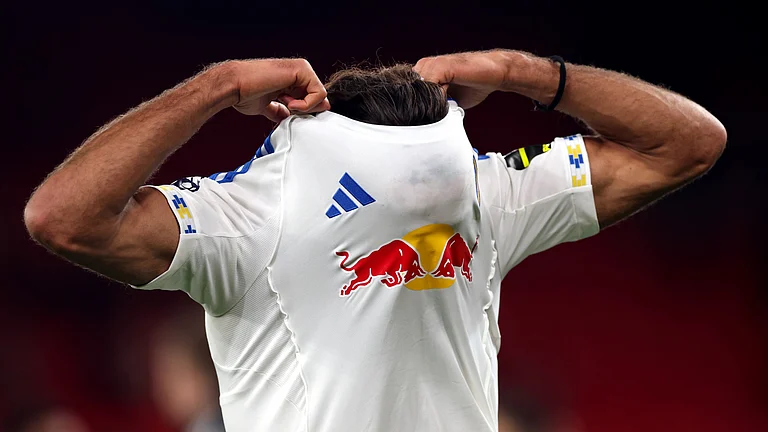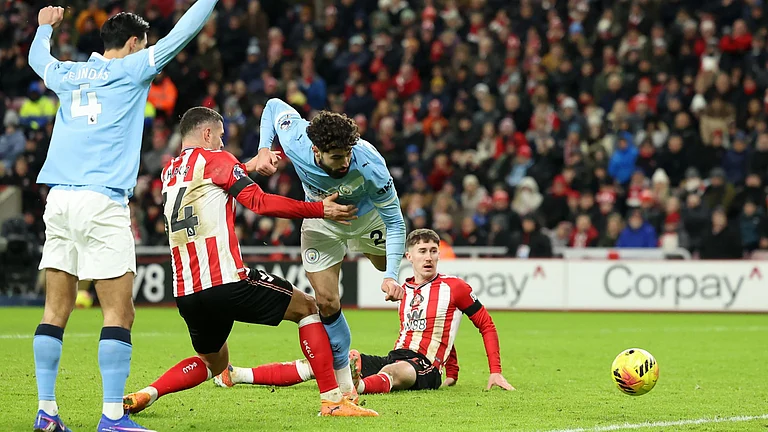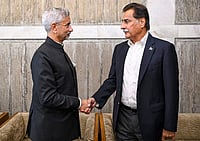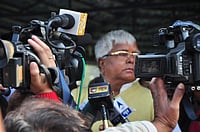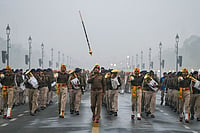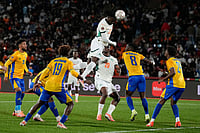IF the Awesome Threesome represent the brash, youthful face of India's strongest batting line-up in 20 years, Mohammed Azharuddin and Navjot Sidhu are the warm, comforting wrinkles. With their oodles of experience, "Azza" and "Sherry", both 35, provide the solidity and stability, and often times the impetus, the team needs on a bad day. As it did on March 25 in Bangalore.
For the first time in the series, an Indian wicket (Laxman) had fallen within a hour of 'play'. Shane Warne was bowling at his tantalising best. Runs were coming in a trickle. And with eight minutes left for lunch, Mark Taylor called on Gavin Robertson. "Ordinarily, bats-men are expected to be cautious in those last few minutes," Sunil Gavaskar said on ESPN.
Not so for "Sixer" Sidhu. He simply strode down the pitch to the offie's very first delivery, but checked himself. Next ball he duly despatched to the stand and flamboyantly repeated the dose with the final delivery. Robertson returned to the fray and Sidhu cut twice. One ball left. A defensive stroke? Not a chance. Sidhu dashed forwards and belted the ball into the city centre.
Sidhu perished soon after lunch when Warne struck, and struck again by removing Dravid. 110 for 3. In came Azhar. Although the series was won, the situation called for some stout resistance. So while Sachin blazed away hundred-wards, he stuck around. By turns, aggressive and defensive, it was all in a day's work for India's "oldest" players, complementing the "kiddos".
"He's getting better as he gets older," Azhar told Gavaskar after Sidhu (eight months younger than the skipper) had yet again scored a 50 in the series, but yet again failed in his stated ambition to score a ton against the Aussies. But if anybody's role in silencing Shane—and retaining the Gavaskar-Border Trophy—has been understated, it is Sidhu's.
In Bangalore, after Calcutta, after Chennai, it was he who set the scene for Rahul and Sachin and Azhar to get after Warne. In fact, the shy, silent opener seemed to have a personal battle of sorts going with Warne, much like Howard Roark in his favourite book Fountainhead. Sidhu won, Shane gave up. In Calcutta, after he had slammed Warne again, Sidhu patted down the next delivery back to the leggie. "Good ball," he called out. Warne, otherwise game for a chat, said: "Shut up!"
In many ways, the just-concluded home series marks a second-coming for the two. Sidhu has just written off his umpteenth obituary having improved his fielding in the process, reportedly at the behest of his young son. Azhar as India's winningest captain. Says Mike Coward of The Australian: "Azhar should get a lot of credit for the series win. The team looks relaxed under him."
It's showing on Azhar, too, who put his younger colleagues in the shade and rattled up the only Indian hundred (an unbeaten 163) in his Eden. When Azhar was stripped of the captaincy in 1996, such astute observers of the game as Mid-Day editor Ayaz Memon gave Azhar two more years in the team as batsman. Back as skipper, and in sparkling form, he now should be looking at two more years.
Azhar's wrist wizardry is still world class, his fielding supreme with 100 catches in the pouch, and his captaincy record defies all known laws of logic and gravity. But, as cricket historian Ramachandra Guha wrote in The Pioneer, Azhar will not make it to many people's All-Time XIs because "his cricketing genius doesn't seem to have translated into stardom, defined as an appeal that is countrywide and persists beyond retirement. "
Nonetheless, with a woe-free Sidhu at the top and a carefree Azhar in the middle, these are comforting times for India's terrific trio. But in the curricula vitae of the two is a fable for the young cricketers: Sidhu debuted in 1983, Azhar a year later in 1984. But this is such a funny game, 15 years down the line, Azhar has played almost double the number of matches (91) as Sidhu (48).








